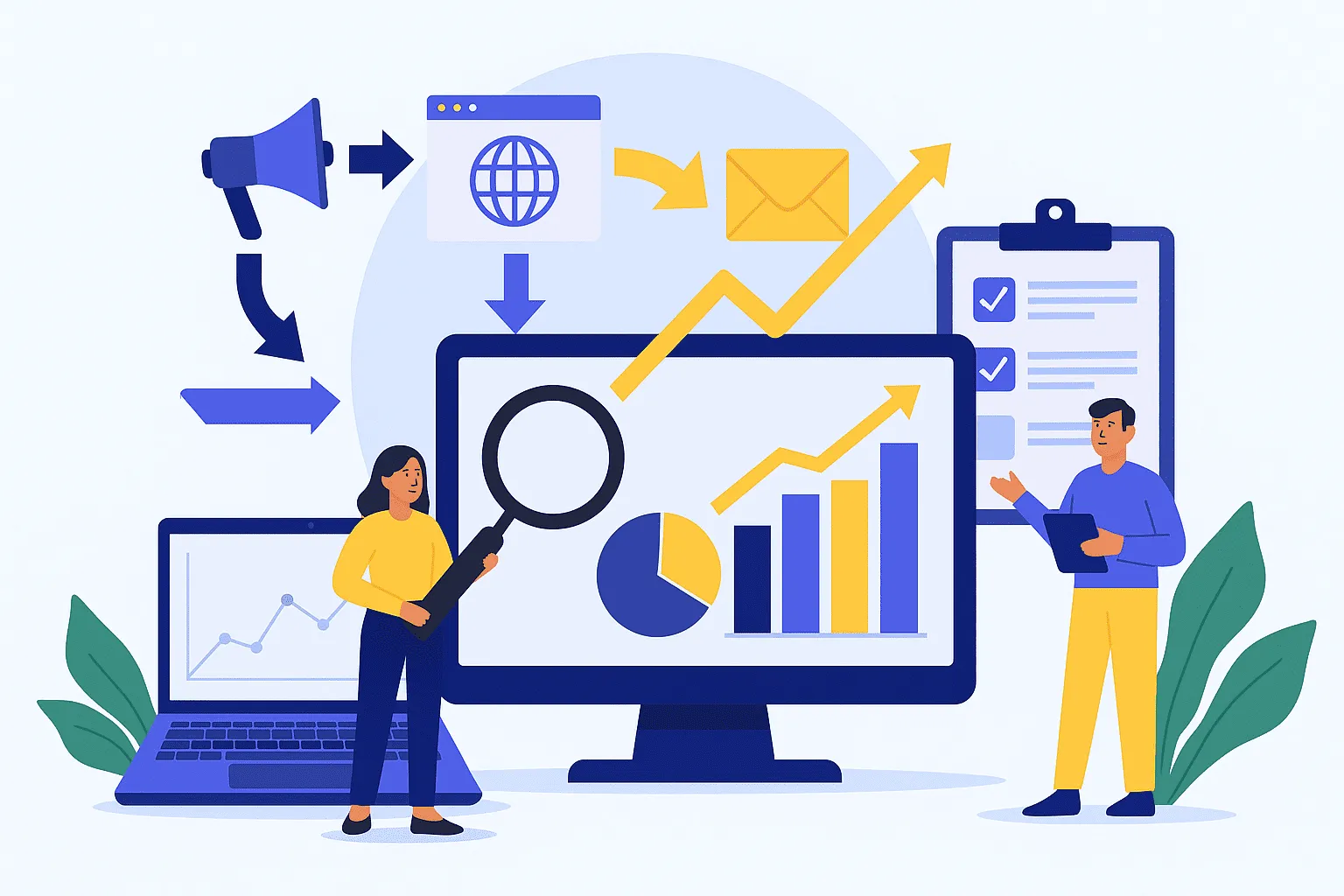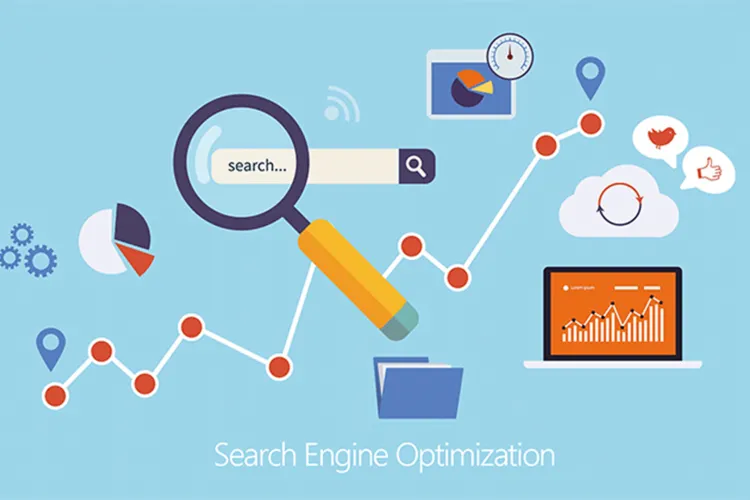
Table of Contents
ToggleWhat is a traffic source
Traffic sources are the sites and services from which users land on your website (search engines like Google and Yandex, social media, email platforms, and other web resources). Any click on a link is recorded as a visit from a specific channel.
Why analyze traffic sources
Traffic source analysis is the process of evaluating the channels that bring users to a website and determining their effectiveness. This involves selecting metrics and UTM tags in advance, setting up analytics systems, and then analyzing the collected information.
The analysis results help us understand where the most valuable traffic comes from, which channels generate leads and sales, and which are underperforming. This data allows us to formulate a well-thought-out promotion strategy, increase conversions, improve user engagement, and strengthen our market position.

Types of website traffic sources
Audiences are attracted to various sources, both paid and free. Let’s look at the main ones.
Direct Visits
Every website strives to increase its share of direct visits—this is a free and highly valuable channel. It reflects the trust and loyalty of its audience: users access the resource through a bookmark, enter the address manually, or click a saved link.
For content portals, a subscriber base that regularly returns for new content is important. For online stores, direct traffic is an indicator of the trust of repeat customers who come without prompting and perform targeted actions.
However, relying solely on direct visits is insufficient—a project always requires an influx of new users. The share of direct traffic serves as an indicator of the resource’s popularity and the quality of its content: if there is no active promotion, but traffic remains stable, the site is in demand.
How to Get Visits from Search
The choice of methods depends on the website owner’s goals. If it is important to quickly increase traffic and improve awareness, cold channels are suitable. If your goal is to generate leads, sales, and actions from an interested audience, you need to focus on “warm” sources.
Proper channel analysis helps you choose the optimal combination and distribute your advertising budget as efficiently as possible.
Search (organic) traffic
In search results, your website competes with other resources providing similar content. In Russia, Google and Yandex hold the largest market share, so their metrics are especially important.
To increase organic traffic, it’s important to:
- Semantic core: A comprehensive list of precise search queries reflecting the site’s topic and user intent.
- Site structure: Clearly structured categories, filters, and product pages; no duplicates, correct pagination, sitemap, high loading speed, optimized microdata.
- Headings and meta tags: Correct H1, Title, and Description tags, automated generation of headings and page titles.
- Internal linking: Transitions should be convenient for both the user and the search engine robot, otherwise, pages will be indexed poorly.
- Relevant content: Articles and texts should address user queries, contain the necessary keywords, and provide high-quality expertise.
In addition to SEO, behavioral factors influence a website’s position:
- Snippet CTR
- Bounce rate
- Returns to search
- Average session duration
- Number of pages viewed
- Website activity
- Social signals
- Diversity of traffic sources
Taking all these parameters into account, you can promote your website to the top and ensure a steady flow of organic visitors.
Contextual advertising with Google Ads and Yandex.Direct
Contextual advertising helps resources that haven’t yet reached the top. But it only works if there’s demand—if the product is new and the market isn’t established, traffic may be minimal.
Google Maps and Yandex.Maps
These are great for B2C companies: pharmacies, restaurants, and banks. For the platform to recommend your business, your card must be filled out correctly and have a high rating and positive reviews.
The cost of this type of traffic is often lower than search advertising—sometimes 5-10 times lower.
Yandex Zen
Creating a corporate blog on Zen allows you to generate inexpensive traffic and create an additional promotion channel. Regular publications, selecting high-quality topics, and actively engaging with your audience can help turn the platform into a sustainable source of traffic.
Image Search
If you properly optimize images (ALT, TITLE, and clear file names), your website can generate traffic from image search. Users who are interested in an image often explore the website itself.
How to Get Traffic from Ad Networks
Contextual Advertising
Contextual ads appear above organic search results, ensuring a high CTR. This channel is ideal for quickly generating leads, as ads start working immediately after launch.
Display Advertising
Display ads include banners, videos, targeted advertising on social media, YAN, and the Display Network.
These formats allow you to:
- Precisely target your audience;
- Configure multiple parameters (interests, demographics, behavior);
- Ensure a high CTR;
- Build reach.
Modern banners are interactive, and RTB auctions allow you to display ads to the right user in real time.
CPA Networks
You pay only for results—registrations, applications, and purchases. This is beneficial for those who value specific actions rather than views. However, the cost per lead is higher here.
Teaser Networks
Teasers provide cheap, high-volume traffic, but not always high-quality. They are used when you need to quickly attract a large number of visitors. Careful performance monitoring is required.
Programmatic RTB
The automated system displays ads to users for whom the offer is most relevant. This technology improves targeting accuracy, reduces costs, and improves conversion.
Social Media Traffic Sources
Users spend a lot of time on social media, so promoting in communities, publishing posts, advertising with bloggers, and working with influencers generate high-quality traffic.
- Targeted advertising on Facebook and Instagram: Allows you to precisely target your audience, from behavior to interests. Card formats (carousel) generate high engagement and quality leads.
- VKontakte Advertising: Works on a similar principle, but is better suited for real estate, services, and e-commerce.
- MyTarget: A large network focused on attracting warm leads. It converts traffic into action.
- Promotional posts: Used to promote promotions and services. An accurate target audience profile is important.
- Paid blog posts: Effective if the author has an active audience that is close to your topic.
- Comments under posts: A cost-effective method of native promotion, but requires precision and authenticity.
- Viral content: Works through a chain reaction: exciting news, unusual stories, memes.
- Links in popular profiles: For example, in gaming accounts, thematic blogs, and specialized communities.
Content Marketing as a Traffic Source
- Blog: Regular blogging generates a steady stream of organic traffic. It’s important to develop a content plan, create useful materials, and maintain audience interest.
- External Publications: Guest articles attract new audiences and build brand trust.
- Expert Comments: High-quality advice in relevant articles helps build authority and attract visitors.
- Books: Publishing your own books enhances your brand’s status and generates additional traffic.
- Webinars: An excellent tool for building trust. With proper preparation, they can generate thousands of new leads.
How to Get Traffic from YouTube
Video is a powerful promotional channel. Regular videos, proper optimization, and interactivity increase traffic to your website.
Remarketing
Remarketing helps bring back users who have already interacted with your website but haven’t completed the desired action. Campaigns should be tailored based on the customer’s actual journey.
Referral Links
Initially, links are placed by agreement. Then, as awareness grows, users begin adding them: in comments, blogs, and forums. The share is small, but valuable.
Email Newsletters
Email is one of the most effective ways to attract repeat users. Emails allow you to present your offer in detail, provide links, and retain customers. With a well-designed strategy, you can build a loyal audience.
Catalogs and Classifieds
An old, but effective method. In some niches, aggregators generate more customers than advertising—for example, Booking or Aviasales.
Banner advertising
Banners are placed on pages based on keywords. The downside is lack of complete control over display placement, but the upside is the ability to attract a targeted audience.
Other traffic generation methods
Depending on the niche, the following may work:
- Reviews on specialized websites;
- Magazine reviews and publications;
- Price comparison services;
- Marketplaces and catalogs.

How to find out the source of traffic
Install Google Analytics and Yandex.Metrica on your website. These systems automatically identify referral channels. Use UTM tags for advertising campaigns—they allow you to track performance down to the individual ad level.
Google Analytics
A tool that shows:
- Number of clicks;
- Number of registrations;
- Page traffic;
- User data.
This helps you adjust your promotion strategy and understand which channels are producing results.
Yandex.Metrica
In addition to standard reports, Metrica offers Webvisor, which includes heatmaps and visitor activity recordings. This greatly helps improve user experience and increase conversions.
A project’s success depends not only on the number of visitors but also on whether they perform targeted actions. To grow traffic and sales, it’s important to use multiple promotion channels, maintain active platforms, and constantly analyze data to adjust your strategy.




